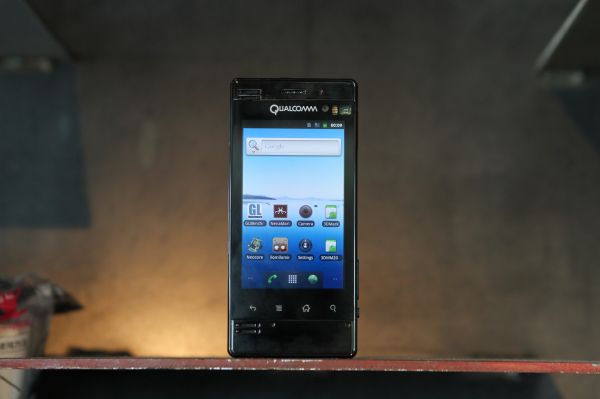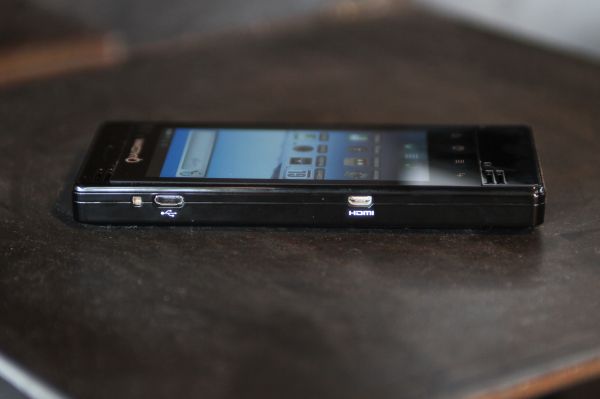Dual Core Snapdragon GPU Performance Explored - 1.5 GHz MSM8660 and Adreno 220 Benchmarks
by Brian Klug on March 30, 2011 4:29 PM EST- Posted in
- Smartphones
- Snapdragon
- Qualcomm
- Adreno
- MSM8660
- MDP
- Mobile
Way back at CES we saw our first glimpse of MSM8x60 and Qualcomm's Snapdragon Mobile Development Platform (MDP) with an MSM8660 SoC inside. Though we couldn't run any benchmarks on it, we got a sneak preview of dual core snapdragon. This year at MWC Qualcomm gave us a considerable amount of hands-on time with the same MDP hardware. We did a bit of testing, and then Qualcomm did something awesome - they let us take an MDP with the MSM8660 inside home with us.
In case you haven't been following, MSM8x60 is Qualcomm's first dual-core SoC. It's two Scorpion cores, an Adreno 220 GPU, and cellular modem all built on the 45 nm process. Like the rest of Qualcomm's lineup, the x in MSM8x60 can either be a 2, denoting GSM, UMTS, and HSPA+ support, or a 6, denoting all the same thing but with CDMA2000 and EVDO. Similarly, 9 will connote LTE support when we get to that point as well. MSM8x60 comes clocked at either 1.2 GHz or a higher 1.5 GHz. The MDP we were given was the higher 1.5 GHz variant. The MSM8x60 is the successor to MSM8x55, which is single core 1 GHz Snapdragon and Adreno 205, also built on 45 nm process.
| Qualcomm Mobile Development Platform (MDP) | |
| SoC | 1.5 GHz 45nm MSM8660 |
| CPU | Dual Core Snapdragon |
| GPU | Adreno 220 |
| RAM | (?) LPDDR2 |
| NAND | 8 GB integrated, microSD slot |
| Cameras | 13 MP Rear Facing with Autofocus and LED Flash, Front Facing (? MP) |
| Display | 3.8" WVGA LCD-TFT with Capacitive Touch |
| Battery | 3.3 Whr removable |
| OS | Android 2.3.2 (Gingerbread) |
It's been a bit busy since we got the MDP home with us, but we've run and re-run tests on the MDP all along and are ready to talk about GPU performance. The MDP we have right now is optimized for evaluating graphics performance, which we'll take a look at in this article. We'll then go into architectural changes between Adreno 200, 205, and 220, and then do the same combo of performance numbers plus architectural deep-dive with the CPU side of things in a future article.
The MDP itself is stark black and completely utilitiarian - it's a glossy, tall, extremely square package, but a smartphone nonetheless. It runs Android 2.3.2 (as an aside, isn't it ironic that prototype devices are running newer builds of Android than most smartphones you can buy retail right now) and has a number of interesting extras. There's a 13 MP rear facing camera with LED flash, front facing camera, 3.8" WVGA display, speakers, microHDMI port, microUSB, and microSD card slot. The MDP's battery is a comparatively tiny 3.3 Whr, but the entire package is totally mobile.
The one we have is again optimized for GPU testing, and sadly lacked cellular connectivity or WiFi, but gets the job done nonetheless.
The MDP's purpose is to act as a pre-commercial handset for software development rather than be something you'd ever carry around. Making reference hardware designed for developers isn't anything new in the SoC space - look no further than OMAP's Blaze platform. Qualcomm started making MDPs with the MSM8655 and sells them through bsquare, who sells them for $995. Though it isn't up yet, both these pages will soon have the MSM8660-based Mobile Development Platform.
One of the more interesting things about the MDP is that because it's a development platform, not a consumer device sold by an OEM though a carrier, it can either have Vsync enabled or disabled. This is the framerate cap we've seen on virtually every other device, which usually is right around 60 Hz. Through adb, we can turn Vsync on or off on the fly, then reboot Android's surface flinger and run tests. Sadly this procedure, while simple on the MDP, doesn't work on any other devices that aren't running Qualcomm's Android builds.
Since all of the devices we've tested thus far have been commercial, they've shipped with Vsync on and thus are limited to around 60 FPS. Thus, more than a few platforms could have had instantaneous bursts during test runs which are clipped to Vsync. To be fair to those, we've run everything on the MDP with Vsync on and off for illustrative purposes.
The MDP we tested was running all out, with maximum clocks and no power management thorottling CPU or GPU clocks down based on usage and load. As a result, testing was performed constantly plugged into a beefy USB AC power adapter. Though these benchmarks show off what MSM8660 is capable of, actual performance in shipping devices will obviously be different depending on UI, power management, and display resolution choices made by Qualcomm's OEM customers, like HTC.



















70 Comments
View All Comments
tipoo - Wednesday, March 30, 2011 - link
Any idea why the iPhone 4 does worse than even the 3GS in the second page benchmarks? And would it be possible to throw an iPad 2 in the comparison, as the dual core A5 chip is more like what this will be competing against?Thanks
Brian Klug - Wednesday, March 30, 2011 - link
The reason for the iPhone 4 lagging iPhone 3GS is display resolution, which unfortunately right now we can't test at anything other than native. GLBenchmark 3.0 will change a lot of that as we'll be able to render off-screen at an arbitrary (common) size.I didn't include the A5 because I didn't include any tablets at all in the comparison.
-Brian
FATCamaro - Wednesday, March 30, 2011 - link
iphone 4 has 4 times the pixels to draw to as opposed to the 3GS. The iPad 2 isn't in the comparison because it would blow everything out of the water.DJMiggy - Wednesday, March 30, 2011 - link
wat?choirbass - Wednesday, March 30, 2011 - link
http://www.anandtech.com/show/4225/the-ipad-2-revi...B3an - Wednesday, March 30, 2011 - link
wateva.GLBenchmark 2.0 Egypt:
iPad 2 = 44
This phone (Adreno 220) = 38.3
GLBenchmark 2.0 Pro:
iPad 2 = 57.6
This phone (Adreno 220) = 93.6
Or Adreeno 220 with vSync = 58.8
Yeah the iPad 2 has a higher res screen, but it's not that much higher. The Adreeno 220 certainly competes. Not bad for a device thats a lot smaller.
snoozemode - Wednesday, March 30, 2011 - link
Not that much higer? The iPad 2 has twice the amount of pixels compared to this phone.choirbass - Wednesday, March 30, 2011 - link
within 6-12 months or so, there should be closely competitive gpus again... always a refresh and release cycle.jalexoid - Wednesday, March 30, 2011 - link
It's not all about the pixels.therealnickdanger - Thursday, March 31, 2011 - link
If you are rendering in native resolution, then yes, yes it is.iPad = 1024x768 = 786,432 = 100%
iPhone = 960x640 = 614,400 = 84%
Adreno = 800x480 = 384,000 = 48%
Adreno doesn't even have to work half as hard as the iPad. While impressive for 480p, Adreno has work to do to catch up to Apple's GPU for higher resolutions.